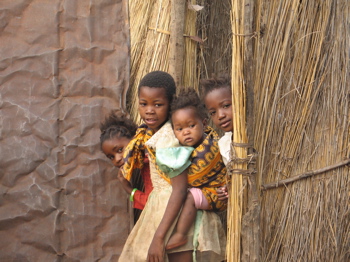
Children of Chief Mukuni’s Village. Photo by Sue Frause.
Author’s Note: My family and I recently returned from Africa. The three of us visited South Africa, Zambia and Botswana and I’ll be sharing some of my stories and photographs from the road with Vagablond readers. It was an amazing adventure!
VICTORIA FALLS, ZAMBIA — Yasim Phiri is a good salesman. As our guide during a tour of Victoria Falls, he mentions another tour that he thinks we’ll like. He’s right. We are looking forward to visiting Chief Mukuni’s Village.
Yasim likes Americans, they’re his favorite tourists. “They’re flexible and supportive,” he explains.
A married father of four children, the oldest named Martin Luther King, he picks us up early one morning at the Zambezi Sun Hotel to drive us to Chief Mukuni’s Village.
Located about 20 minutes from the hotel, the drive to the village is bumpy on the primitive dirt road. There are people out walking, some talking on cell phones. Guinea fowl and impalas make their morning rounds. Women carry an array of items on their heads, and the Mukuni Model School proclaims Success Through Hard Work on its sign.
Mukuni is home to the Leya people, or Tokaleya as they now call themselves. It’s been in existence for more than 700 years, and today the working community boasts approximately 7,000 residents.
Our village guide is 30-year-old Frances Chileshe, a volunteer who was appointed by Chief Mukuni. The father of two children, Frances grew up here.
He explains that Mukuni means Big Tree, and meetings are still held under a giant acacia tree. He points out Chief Mukuni’s palace called Lumpasa or Lion’s Den. It’s not your typical palace, but simple like the rest of the dwellings in this village.
Mukuni is ruled jointly by Chief Mukuni and a queen known as Be Dyango. I discover later that Dr. David Livingstone visited the village occasionally. Two men from the village carried his body all the way to the coast after he died near Lake Bangweulu in 1873.
Frances tells us that famillies live in clusters or near each other. Chickens and goats roam freely around the village which is home to mango, banana and papaya trees.
We are allowed to go inside two of the homes. One is all tricked out at the entrance with flowers and plants. The touch of green is refreshing.
A doctor visits the village three times a week. Frances smiles when I ask him for his e-mail address: he goes into Livingstone twice a week to check his e-mails. I promise I’ll send him a link to my blog when I return home.
The village is quiet this morning. It’s Election Day in Zambia, a holiday for the people. Later we find out that incumbent Levy Mwanawasa won the election; and that there were protests in the Zambian capital of Lusaka by citizens who said the election was rigged.
As we walk around the village I have to remind myself that this is not a movie set. This is not a summer camp. This is home. Houses are made of grass wall fencing that needs to be replaced every two years. The straw roofs have to be redone every five years.
Women line up for water. Fortunately, a Norwegian humanitarian project brought water to the village more than a decade ago.
We’ve brought along tee-shirts and pens. The children of the village mob me as I pull out dozens of inexpensive pens from my backpack. We use the tee-shirts plus cash to purchase handmade crafts from the curio shop. I buy a simple necklace from Jethro, and he is happy to make the sale and pose for a photograph.
The children wave as we leave. It feels strange to go back to our nice hotel.